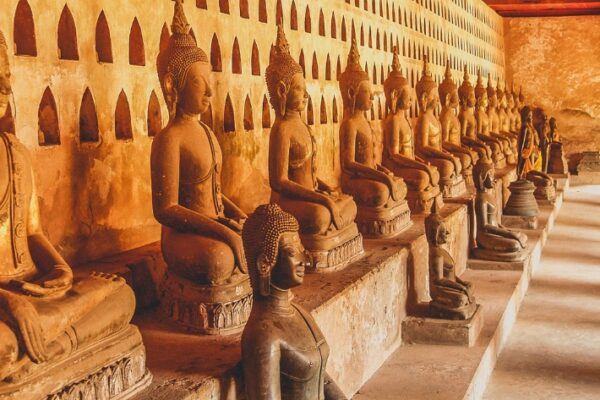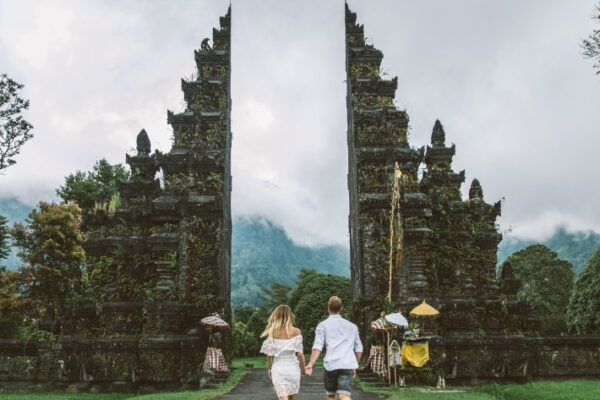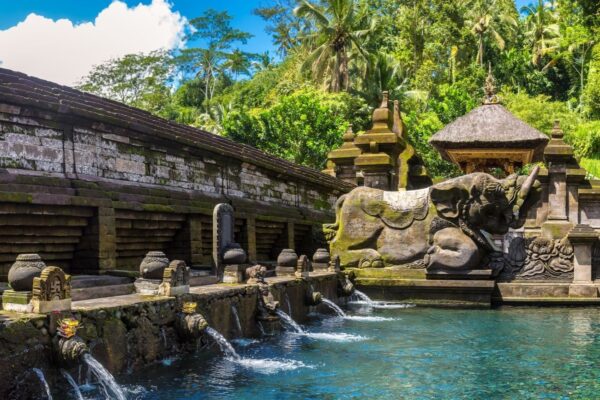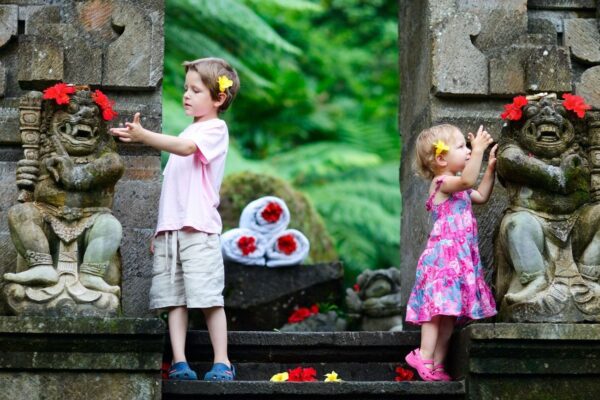Explore the Best Temples in Bali for Culture, Views, and Inner Peace
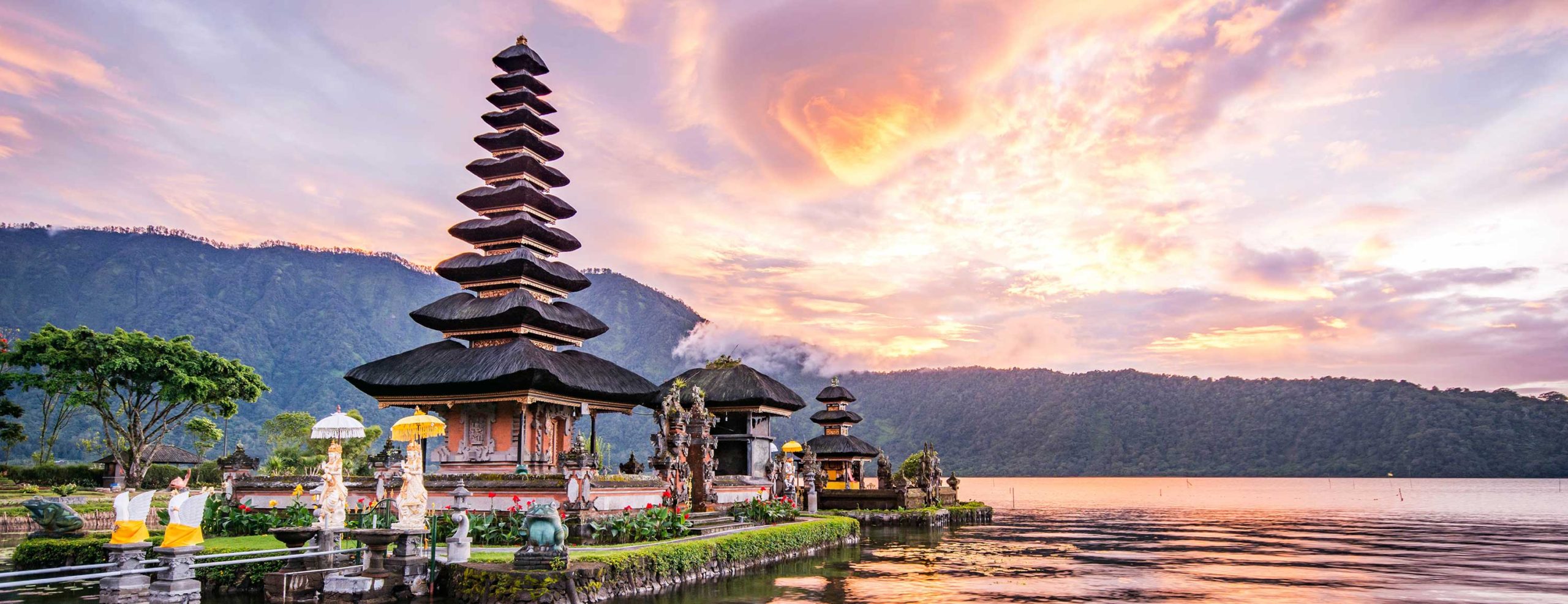
Bali is known for its surf, beaches, and vibrant culture, but what truly sets the island apart are its temples. Temples in Bali are more than religious sites. They are windows into the island’s spiritual life, architectural heritage, and timeless rituals. Each temple carries its own story, set against backdrops of volcanoes, cliffs, or rice paddies. Some are quiet village shrines. Others host colorful ceremonies open to curious travelers. Visiting them offers a deeper connection to Balinese tradition. In this guide, you’ll discover the most beautiful temples in Bali, how to visit respectfully, and tips to plan your journey with ease.
Why Temples In Bali Will Take Your Breath Away
Few places blend spirituality, nature, and design like temples in Bali. These sacred sites are more than religious landmarks. They are moments of awe tucked into cliff edges, jungle valleys, and peaceful lakes. Every visit feels like stepping into a dream carved in stone and filled with stories.
Unreal Settings That Seem Almost Imagined
Standing on a cliff at Uluwatu, with waves crashing 70 meters below, or watching Tanah Lot rise from the sea at sunset, it’s hard to believe what you’re seeing is real. Ulun Danu Beratan appears to float on a still lake surrounded by mountains. Other temples, like Goa Giri Putri, hidden inside a massive limestone cave, turn the act of entering into an adventure. These backdrops make visiting temples feel like walking through a postcard.
Photography That Captures Magic, Not Just Memories
There’s a reason temples in Bali dominate travel feeds. At places like Tirta Gangga, stepping stones across koi ponds turn every photo into a painting. Sunrise at Pura Segara Ulun Danu Batur glows gold. Even the famed “Gates of Heaven” at Lempuyang Temple, while often overhyped, still offer breathtaking views of Mount Agung when the clouds clear. The temples practically frame themselves.
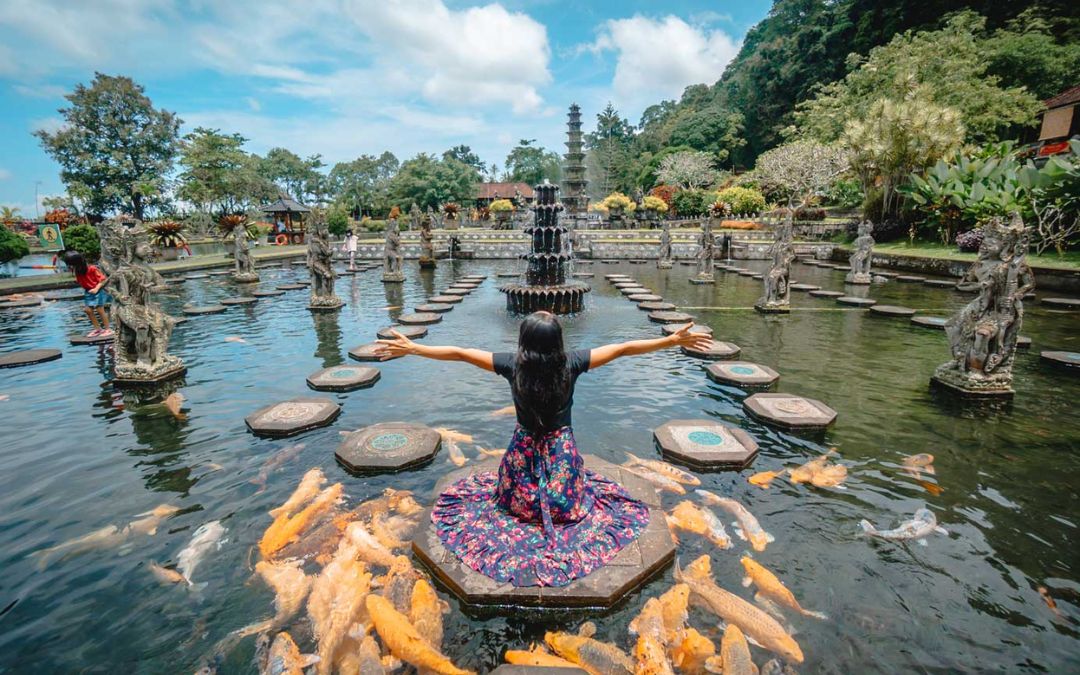
Tirta Gangga – a royal water palace of serenity and sacred beauty.
A Spiritual Presence You Can Feel
Temples here are alive with rituals, prayers, and offerings. They are woven into daily life. At Tirta Empul, locals and travelers alike gather for water purification in sacred pools. Besakih Temple hosts ceremonies that stretch across vast terraces. Temples like Uluwatu protect the coastline through unseen spiritual networks. Every flower, every incense stick, feels purposeful. Even as a visitor, you can sense the energy.
Stories and Symbols in Every Stone
Walk through Goa Gajah and you’ll see a giant stone face carved into a cave mouth, its expression both fierce and mysterious. At Gunung Kawi, 11th-century shrines carved into jungle cliffs stand like forgotten guardians. These temples aren’t just old — they speak in the language of mythology, kings, and cosmic balance. Even the smaller sites like Penataran Sasih carry centuries of symbolism.
Moments of Quiet in Unexpected Places
Temples don’t have to be grand to be powerful. Wander into a quiet courtyard at Pura Melanting or sit by the edge of the Goa Garba Ruins and listen to the jungle breathe. Visit early in the morning, and even busy sites like Tirta Empul feel serene. With a little timing and curiosity, it’s easy to find stillness, even in the island’s most visited spots.
>> Read More: What to Do in Bali for 7 Days – A Perfect Itinerary for First Timers
Coastal and Sea Temples in Bali You Shouldn’t Miss
Few temples in Bali are as dramatic and photogenic as the sea temples that guard the island’s coastline. These sacred spots sit perched on cliffs or rocks above the Indian Ocean, offering a blend of ancient spiritual purpose and unforgettable views. Two of the most iconic sea temples you’ll want to see are Tanah Lot and Uluwatu.
Tanah Lot: Bali’s Most Iconic Sea Temple
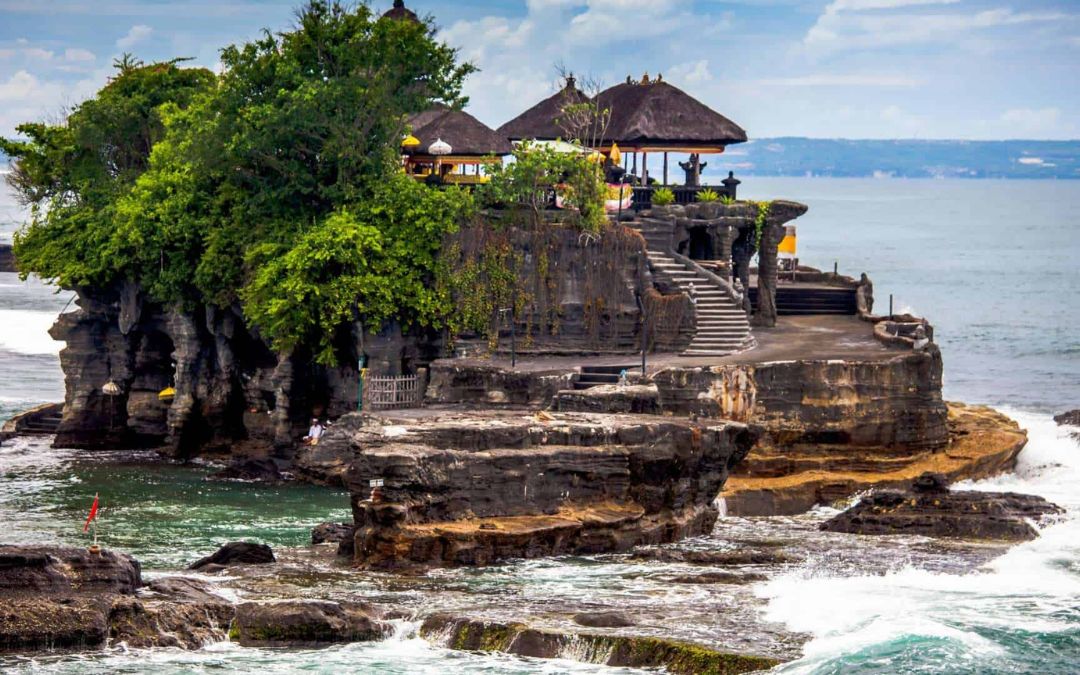
Tanah Lot rises from the sea, captivating visitors with sacred ocean views.
Tanah Lot means “land in the sea,” and it truly lives up to its name. This temple sits on a rocky outcrop surrounded by crashing waves, creating the illusion of floating at high tide. Its silhouette against the setting sun is one of Bali’s most famous images, making it a must-visit for photographers and sunset seekers alike.
Entrance costs around IDR 75,000 (about $5 USD). The best time to visit is just before sunset when the light is golden and the tide is low enough to walk across to the temple’s base. While tourists cannot enter the temple itself, you can still receive a blessing at its base. Just be aware — it gets very crowded, so arrive early for the best spot.
This site is also spiritually significant. Though you can’t always see them, locals believe that venomous sea snakes live in the crevices near the temple, guarding it from evil spirits. While modern visitors come for the view, Tanah Lot remains an active place of worship and a major pilgrimage site for Balinese Hindus.
Uluwatu Temple: Clifftop Views and Sunset Rituals
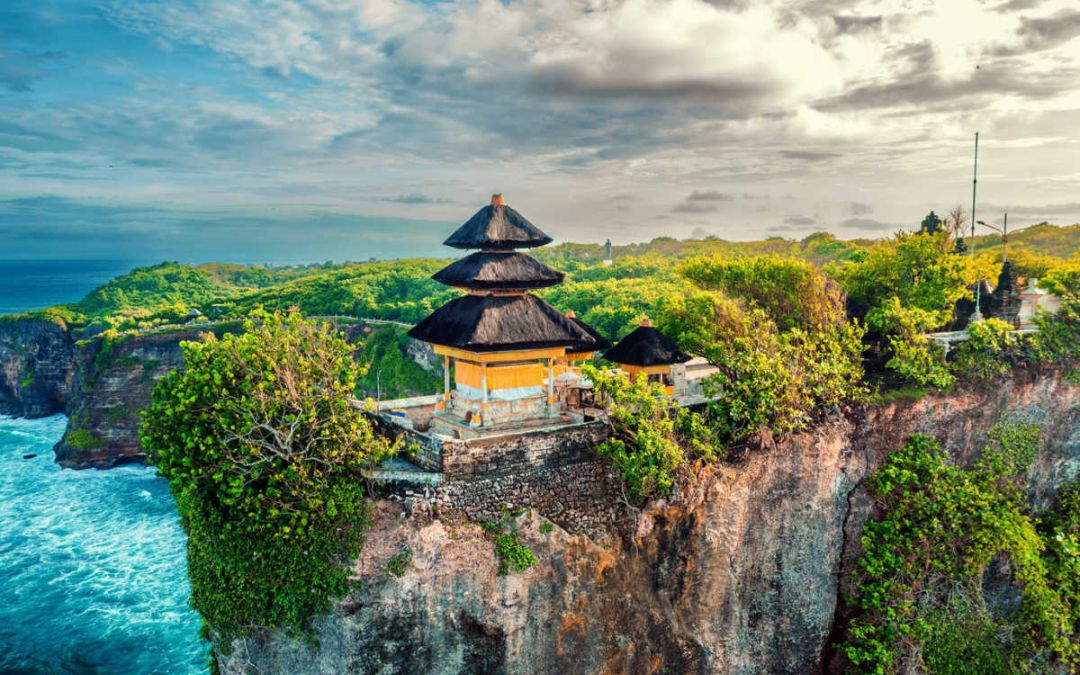
Bali’s golden sunset light bathes Uluwatu Temple atop the dramatic cliffs.
Uluwatu Temple is a dramatic sight, perched 70 meters above the sea on a rugged cliff edge in Bali’s far south. This temple is one of the island’s most important pura segara, or sea temples, meant to protect Bali from evil spirits. The setting is jaw-dropping, with expansive ocean views that light up during sunset.
The temple is also famous for its daily Kecak fire dance, performed in an open-air amphitheater right as the sun dips into the ocean. The dance begins at 6 PM, so it’s best to arrive by 5 PM to walk the cliff paths and explore the temple beforehand. Booking tickets in advance is highly recommended.
Keep a close eye on your belongings. The site is home to cheeky macaques known for snatching sunglasses, phones, and hats. Despite the monkey mischief, the sunsets here are unforgettable. If you’re looking for the perfect photo moment, the golden hour during the Kecak dance delivers the kind of glow that Bali is famous for.
>> See tour: Bali Essence Tour 5 Days
Top Water Temples in Bali for Culture, Ceremony, and Calm
Some of the most spiritually powerful temples in Bali are built around natural springs and tranquil lakes. These water temples offer a deep sense of peace and tradition, blending sacred rituals with serene landscapes. Two standout spots are Tirta Empul and Ulun Danu Beratan.
Tirta Empul: Holy Springs and Spiritual Cleansing
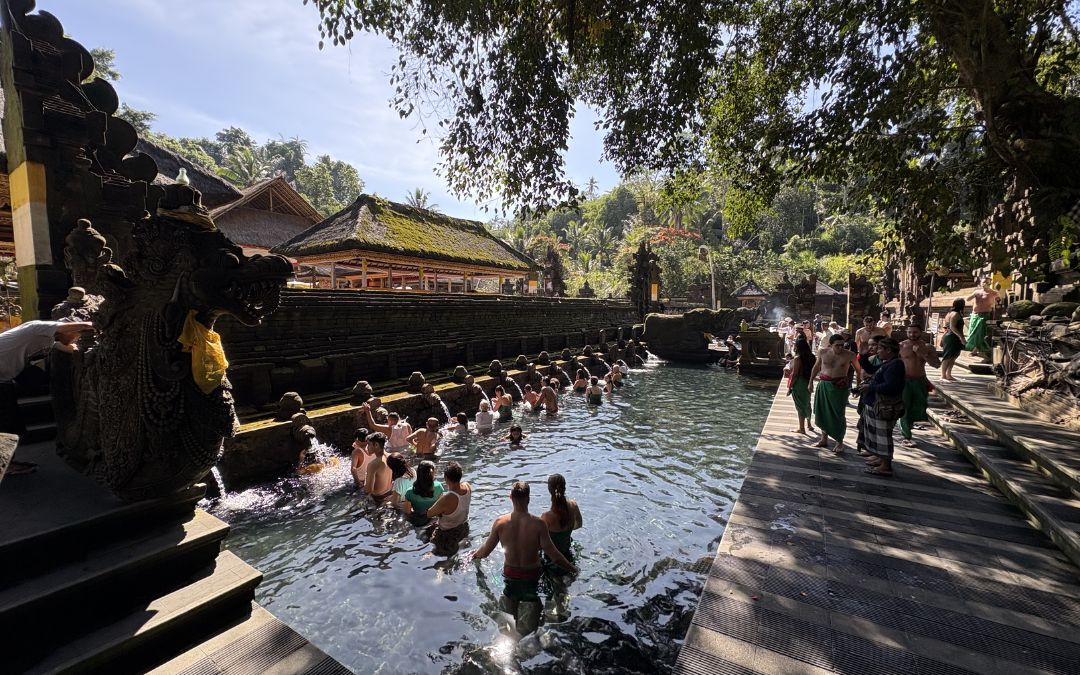
Pilgrims seek blessings in the sacred spring waters of Tirta Empul.
- Entrance Fee: 50,000 IDR (around $3.25 USD) including sarong rental.
- Tip: Changing facilities are basic. Wear your swimsuit under your clothes and bring a towel and dry change.
Built in the 10th century near Tampaksiring, Tirta Empul is one of the holiest temples in Bali. It’s famous for its Melukat ritual — a purification bath in sacred spring water that flows through a series of beautifully carved fountains. Locals and visitors alike come to bathe, pray, and refresh their spirits.
To join the ritual, rent a sarong at the entrance, make a small offering, and follow the queue, moving left to right. Guides are helpful, not just for explaining the process, but also for keeping things respectful. Visit between 7 AM and 8:30 AM to avoid crowds and experience the temple in peaceful silence.
Ulun Danu Beratan: The Floating Temple of the Highlands
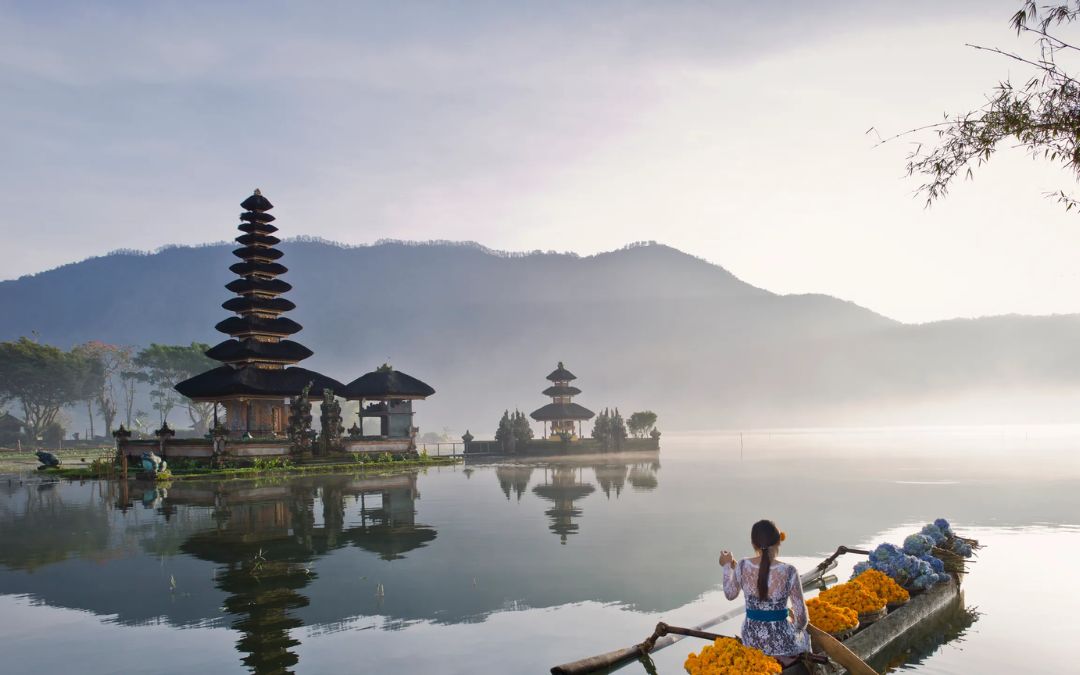
Ulun Danu Beratan floats in calm waters, framed by misty highland peaks.
- Entrance Fee: Up to 75,000 IDR ($5 USD), depending on the season and ticket package.
- Tip: Boat rental is around 200,000 IDR ($13 USD) for one hour, with a local guide available.
Ulun Danu Beratan looks like something out of a dream. This temple rests on the shores of Lake Bratan, and when the water is calm, it seems to float. Surrounded by misty mountains and flower gardens, it’s one of the most photographed temples in Bali — and for good reason.
The temple is often crowded with tourists, and the area has gained some commercial clutter. But you can still find peace. Rent a small wooden boat and drift onto the lake for a different perspective, away from selfie sticks and souvenir stalls. It’s the best way to soak in the temple’s serene beauty.
Mountain Temples in Bali with Epic Views and Deep Spiritual Roots
If you’re chasing epic mountain views with a dose of sacred atmosphere, these elevated temples in Bali won’t disappoint. Often built high into volcanic slopes, they serve as spiritual anchors and offer stunning landscapes. Two of the most famous are Pura Luhur Lempuyang and Besakih Temple.
Pura Luhur Lempuyang: Sunrise and the “Gates of Heaven”
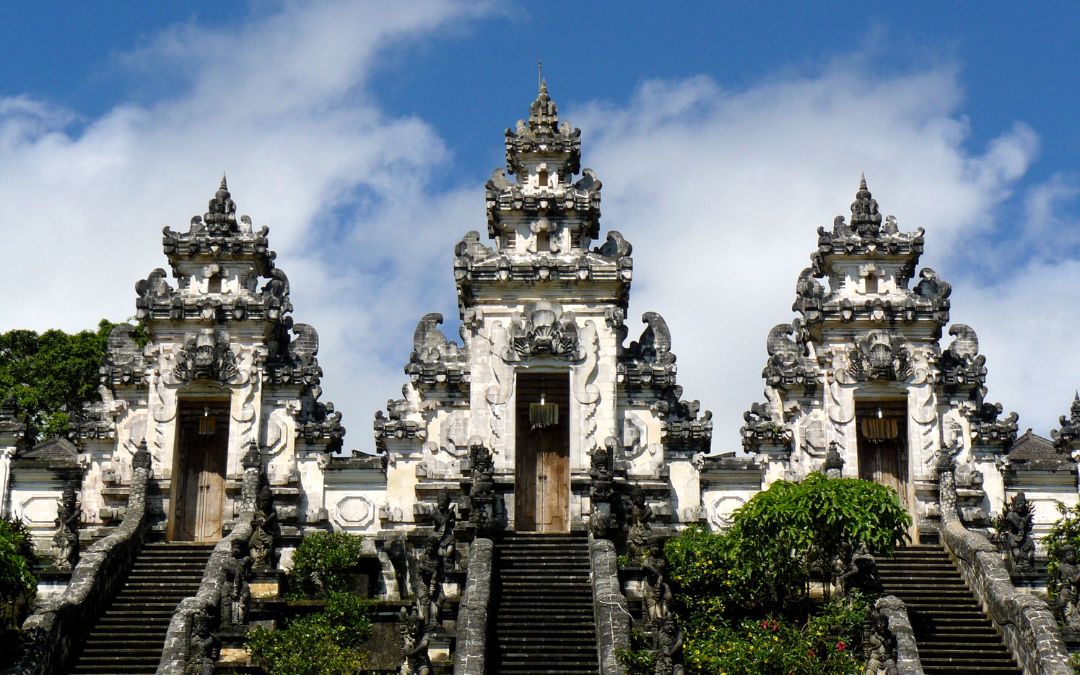
Sacred split gates frame the skies as Pura Luhur Lempuyang rises behind.
- Tip: Wear proper footwear and bring water for the hike. Sarong rental is often required, and while fees may vary, a donation of 20,000 IDR is usually appreciated.
Set on the slopes of Mount Lempuyang, this temple complex is home to the famed “Gates of Heaven,” framing Mount Agung in the background. It’s one of Bali’s oldest temples and still one of its most sacred. If you’ve seen those iconic split-gate photos, this is where they’re taken.
To get there, prepare for a steep climb — over 1,700 steps lead up to the main temple. Tourists flock here daily, often waiting hours just for a single photo. The best plan is to join a sunrise tour around 4 AM. This gives you the clearest view of Mount Agung before clouds roll in. Be aware: the famous reflection in Instagram shots is actually created using a mirror, not water.
Besakih Temple: The Grandest of All Balinese Temples
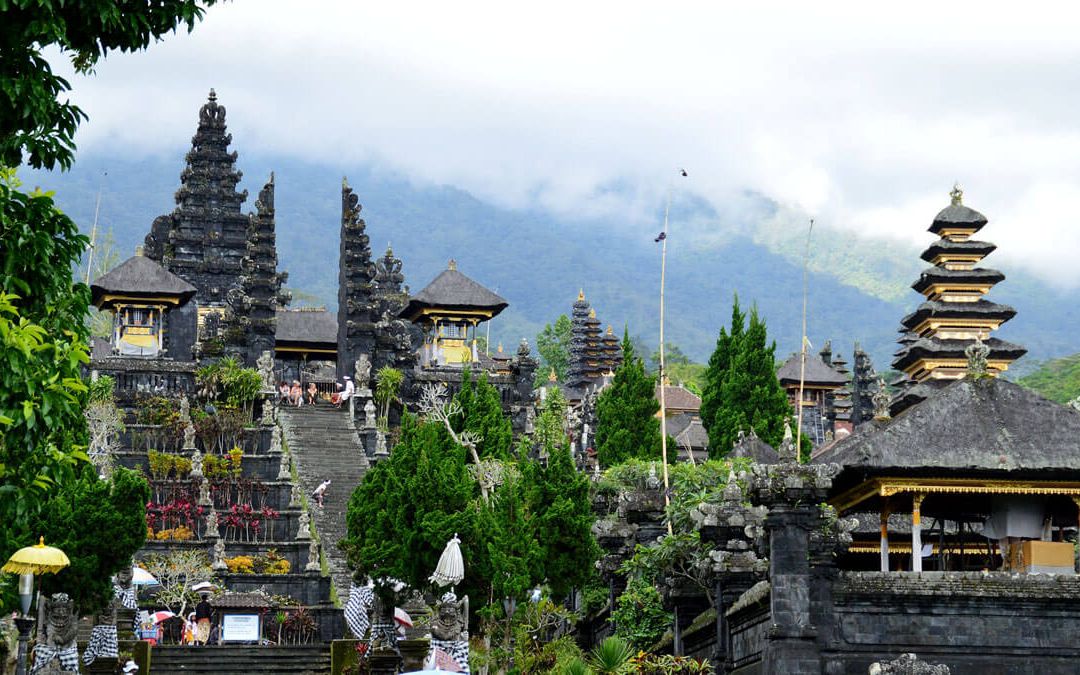
Besakih Temple rises grandly as Bali’s spiritual heart on Mount Agung’s slope.
- Entrance Fee: Around 60,000–90,000 IDR per person. This may include a sarong, a local guide, and a shuttle from the parking area.
- Tip: Sarongs and sashes are required. Visit in the early morning for better light and fewer crowds. Allow at least 2–3 hours to explore the main complex.
Known as the “Mother Temple,” Besakih sits on the western slopes of Mount Agung and is the largest and most important temple complex in Bali. It includes more than 80 temples and shrines, each with its own unique spiritual role. This is not just a site — it’s a living religious hub for the island’s Hindu population.
The temple is tiered across a large hill, with stone staircases and expansive views of rice fields, valleys, and distant mountains. It hosts frequent ceremonies year-round, making it an amazing place to witness Balinese spiritual life in action. A higher point within the complex, Pura Pengubengan, offers panoramic views from 1,000 meters above sea level.
Temples in Bali with Rock and Cave Sanctuaries
Hidden in valleys and carved into ancient cliffs, some temples in Bali feel like they belong to another world. One of the most striking examples is Gunung Kawi — a spiritual site wrapped in jungle, legends, and stone.
Gunung Kawi: Cliffside Shrines and Jungle Stillness
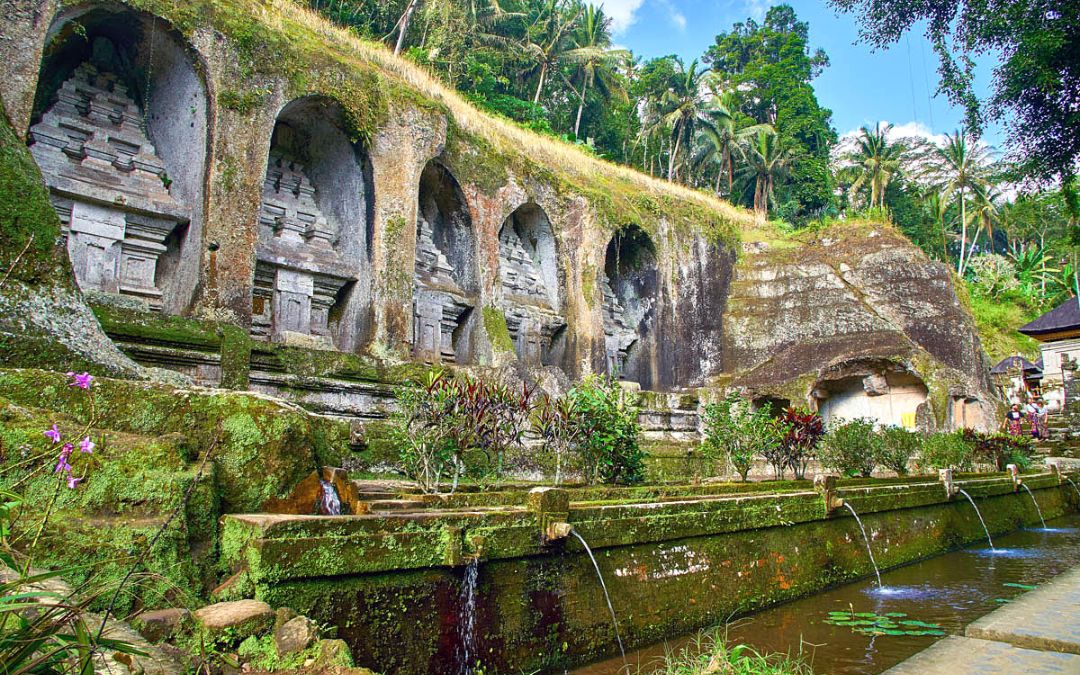
Those who seek stillness may find peace in Gunung Kawi’s cliffside shrines.
- Tip: Wear walking shoes and bring water. The climb back up is steep, but the scenery makes it well worth the effort.
Gunung Kawi is an 11th-century temple complex nestled in a lush river valley north of Ubud. Its ten shrines are carved straight into towering rock cliffs, standing over 7 meters high. These massive monuments are believed to honor King Anak Wungsu and his queens. According to local legend, the giant Kebo Iwa carved them overnight with his bare hands — a myth that adds even more mystique to the site.
The setting is what makes Gunung Kawi truly special. To reach it, you descend about 300 steps through rice terraces and banana groves, with the sacred Pakerisan River flowing nearby. It feels peaceful and untouched, especially in the early morning. The temple is open daily from 8 AM to 6 PM, with an entrance fee of 50,000 IDR (around $3.25 USD), which includes a sarong.
Goa Gajah: The Elephant Cave with a Carved Entrance
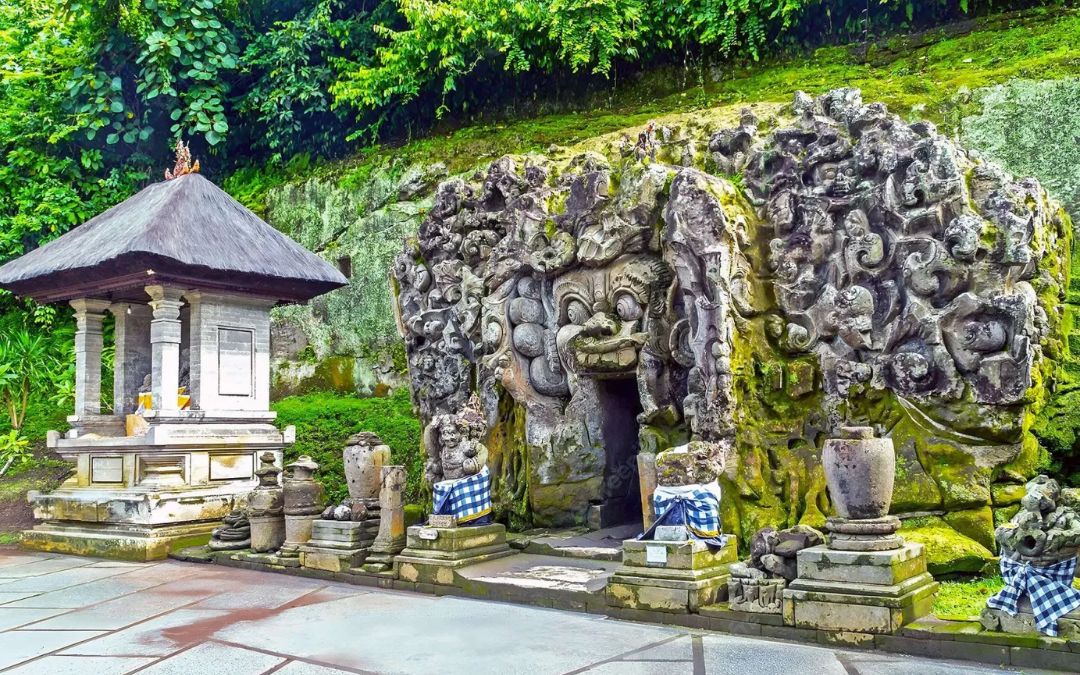
The demon-carved entrance welcomes curious souls into Goa Gajah’s sacred cave.
- Tip: Visit early in the day before the Ubud day tours arrive. Bring small cash for entry and sarong rental if needed.
Located just 10 minutes from Ubud, Goa Gajah, or the Elephant Cave, is an ancient meditation site carved into a hillside. Its iconic entrance — a demonic face with an open mouth — leads into a shallow cave once used by monks. Inside, you’ll find stone idols, incense-scented air, and echoes of centuries-old chants.
Outside the cave, the complex includes bathing pools, garden paths, and hidden Buddhist relics by the riverside. It’s one of the few Bali temples where Hindu and Buddhist influences visibly coexist. Guides are available but optional, and exploring the grounds takes less than an hour.
> See Tour: Classic Java Bali Tour 7 Days
Temples in Bali with Garden Beauty and Cultural Gems
Not all temples in Bali are perched on cliffs or hidden in caves. Some sit quietly in the heart of towns or among royal gardens, offering a peaceful escape and a chance to experience Bali’s artistic side. Two such temples worth visiting are Pura Taman Saraswati and Pura Taman Ayun.
Pura Taman Saraswati: Ubud’s Lotus-Covered Water Palace
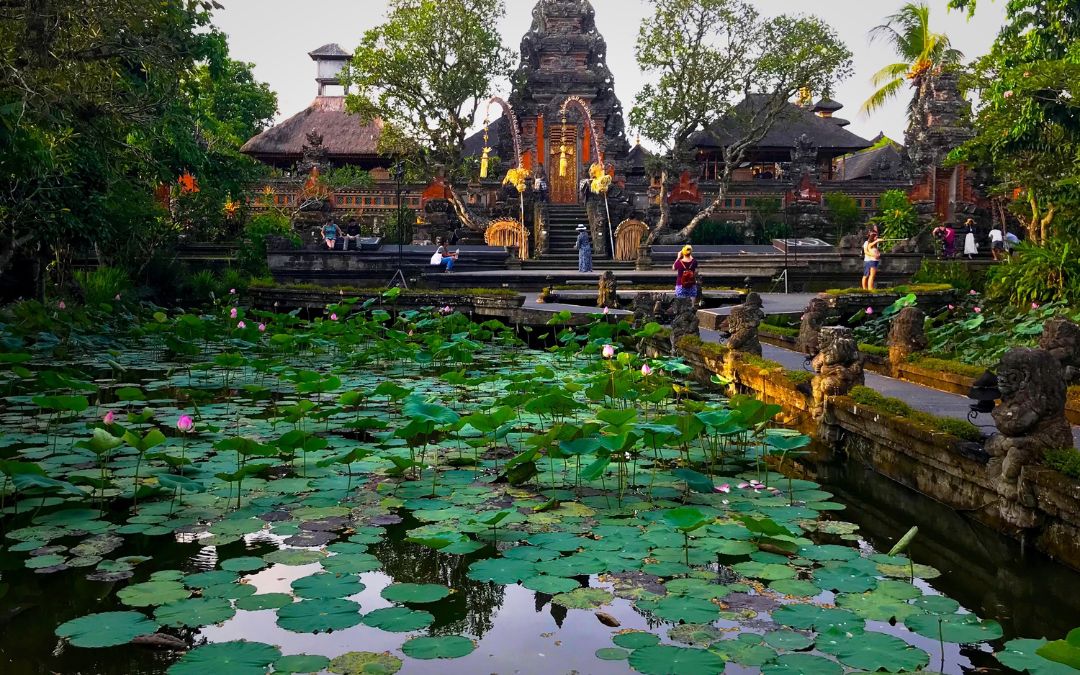
Visitors follow lotus-lined paths into the calm of Pura Taman Saraswati.
- Tip: Visit before heading to the Ubud Art Market to avoid lugging bags around during your temple stroll.
Right in the middle of Ubud, Pura Taman Saraswati blends sacred space with elegant design. Dedicated to the goddess of knowledge and the arts, Saraswati, the temple features stunning lotus ponds flanking a pathway that leads to its ornately carved gates. It’s a favorite stop for quiet moments and eye-catching photos.
In the evening, the temple comes alive with traditional Balinese dance performances on an open-air stage at 7:30 PM. Tickets cost 100,000 IDR, and seats fill up fast, especially in high season. For a more laid-back experience, reserve a table at Cafe Lotus next door and enjoy dinner with a view of the show. Entry to the temple is 50,000 IDR, including sarong and jacket rental.
Pura Taman Ayun: Royal Temples, Moats, and UNESCO Recognition
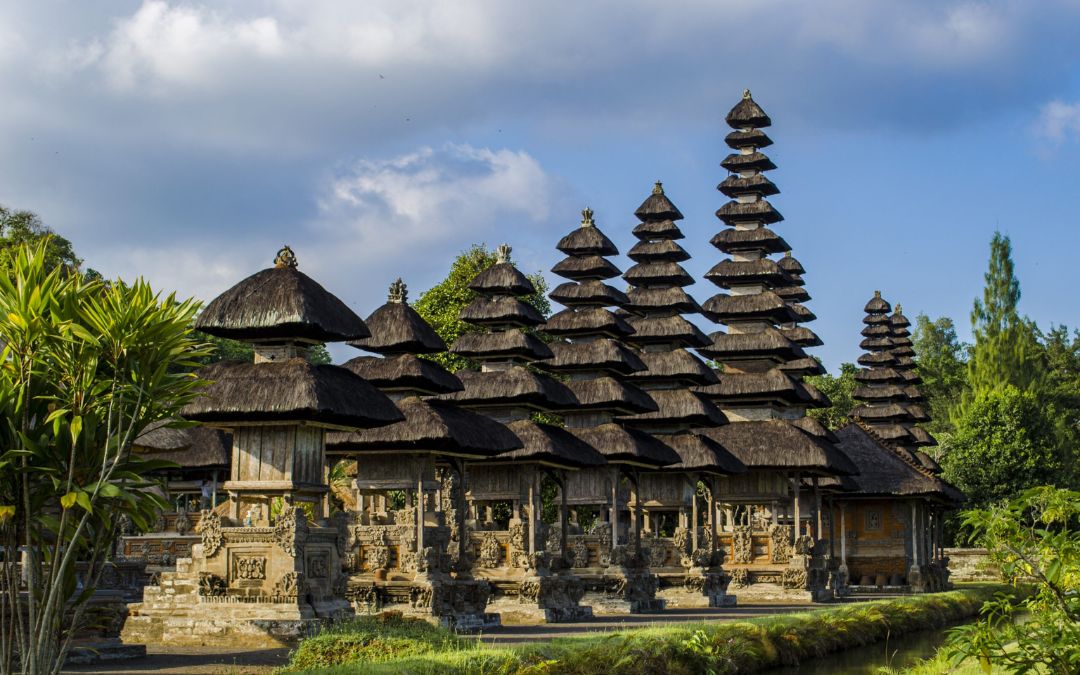
Thatched pagodas rise quietly behind the moats of Pura Taman Ayun.
- Tip: Set aside at least an hour to explore. This is one of Bali’s best-kept photogenic secrets, with peaceful, green, and crowd-free.
Located in the village of Mengwi, Pura Taman Ayun is a 17th-century temple complex once used by the royal family. Surrounded by moats, lotus ponds, and manicured courtyards, it’s one of the few temples in Bali recognized as a UNESCO World Heritage Site, thanks to its role in the island’s ancient irrigation system.
The temple’s classic Balinese design includes thatched pagodas, wide courtyards, and a serene inner complex dedicated to past kings. There’s also a small museum with photos and films that bring the temple’s history to life. It’s usually quiet, giving you space to wander slowly. Entrance costs 20,000–30,000 IDR, cash only.
Practical Travel Guide for Visiting Bali’s Temples
Before heading out to explore temples in Bali, here are a few key tips to help you stay respectful, comfortable, and fully prepared.
- Follow the dress code: Always wear a sarong and sash before entering any temple. Most entrances offer free rentals, but avoid buying one from pushy vendors who claim it’s required.
- Dress respectfully: Avoid revealing tops, clothing with profanity, or swimwear. Some temples may also require a shoulder-covering jacket, included in entry fees.
- Carry cash: Most temples only accept cash for entrance fees and parking. Bring small bills to avoid hassle.
- Time your visits right: Go early for peace and better lighting. Tirta Empul is best before 8:30 AM, while Tanah Lot and Uluwatu shine at sunset. Book Kecak tickets in advance if visiting Uluwatu in the evening.
- Expect stairs and walking: Temples like Gunung Kawi and Lempuyang require long stair climbs. Wear sturdy shoes and carry water. Other sites like Goa Gajah involve gentler slopes but still require walking.
- Hire a guide when needed: At Tirta Empul, a local guide helps with the purification ritual. Some sites offer optional guides who share local legends and temple history.
- Get around easily: Rent a scooter if you’re confident driving. Otherwise, hire a private driver for the day (around IDR 700,000), especially if visiting multiple temples.
- Respect the sacred atmosphere: Temples are active places of worship. Keep your voice low, silence your phone, and never interrupt ceremonies or step onto altars.
- Watch out for monkeys: At Uluwatu, macaques are notorious for stealing sunglasses, phones, and snacks. Keep your belongings secured at all times.
- Avoid tourist traps: At Ulun Danu Beratan, skip the photo props and consider hiring a boat to view the temple from the lake. It’s quieter and more scenic.
- Don’t expect a lake at Lempuyang: The “mirror lake” photo at the Gates of Heaven is staged using a handheld mirror. Be ready for long queues just for one photo.
- Prepare for basic facilities: At Tirta Empul, changing rooms are minimal. Wear your swimsuit under your clothes and bring a towel and a change of clothes.
Experience the Best of Temples in Bali Without the Guesswork
Exploring the temples in Bali is a journey into the island’s soul. From jungle-carved shrines to floating sanctuaries and sacred mountain gates, each temple tells a story steeped in spirituality, history, and natural beauty.
If you’re looking to make the most of your temple adventure without the stress of planning, let Asia Pioneer Travel design a custom itinerary for you. We will connect you with trusted local guides, handle the logistics, and make sure you don’t miss a single sunrise, ritual, or hidden gem.
